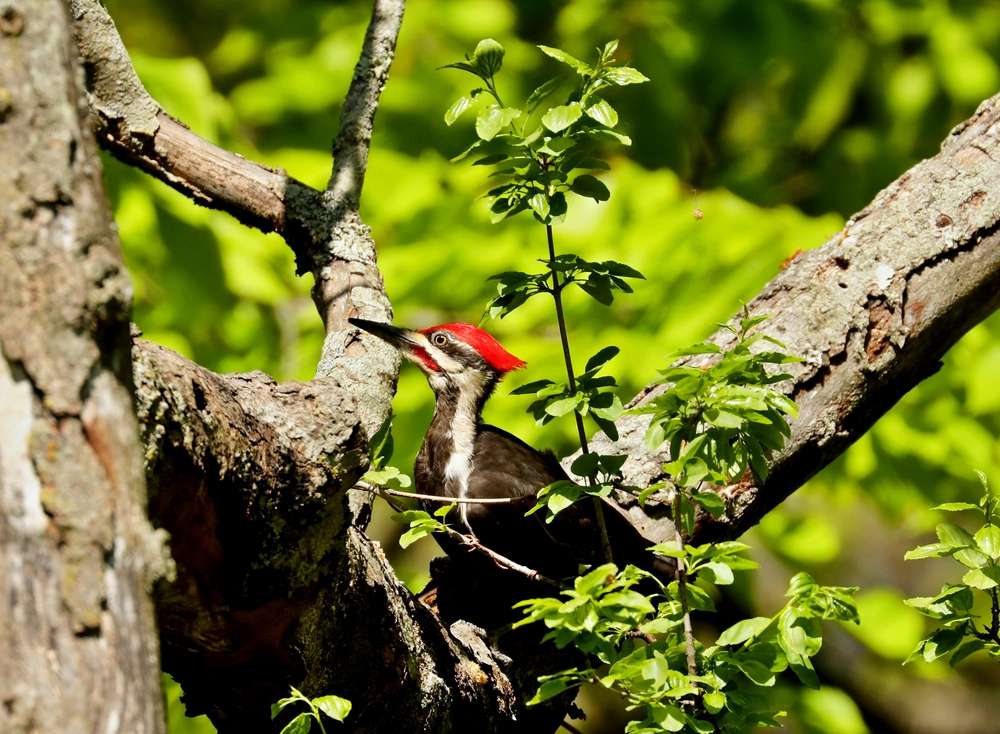A Pivotal Sighting: Ivory-Billed Woodpecker Resurfaces

In the depths of a Louisiana forest, the self-taught ornithologist Mark A. Michaels experiences a momentous event—a potential sighting of the elusive ivory-billed woodpecker. The species, not definitively identified in the wild since 1944, sparks scientific fascination, amplifying the significance of Michaels’ claim. This encounter unfolds against the backdrop of the U.S. Fish and Wildlife Service’s (USFWS) proposal in September 2021 to declare the ivory-billed woodpecker, among other species, extinct.
Michaels, a research associate at the National Aviary, has dedicated about 15 years to seeking the ivory-billed woodpecker, and while he has had previous sightings, none convinced him entirely. However, this particular encounter stood out, leading him to confidently identify the bird based on its size, long neck, and distinctive flight behavior. The proposed extinction declaration by USFWS raised debates and concerns within the scientific community, emphasizing the challenges of determining a species’ extinction definitively. The data supporting the proposal faced scrutiny, and conflicting evidence presented during a public hearing in January 2022 prompted USFWS to issue a stay of extinction, allowing six more months of review before a final decision on the ivory-billed woodpecker’s status.
The ongoing case underscores the complexities scientists encounter in confirming a species’ extinction. Proving the absence of a species is inherently challenging, as ecologist H. Resit Akçakaya notes, and a lack of verifiable sightings does not necessarily constitute evidence of extinction. The International Union for Conservation of Nature (IUCN) provides guidelines for determining extinction, emphasizing the need for certainty when declaring a taxon extinct. The potential ramifications of declaring a species extinct prematurely are significant, as it can impact conservation efforts and resource allocation, potentially leading to a “Romeo Error” where the belief in extinction becomes a self-fulfilling prophecy.
Michaels, a research associate at the National Aviary, has dedicated about 15 years to seeking the ivory-billed woodpecker. His encounter prompts reflection on the species’ historical elusiveness and the challenges associated with confirming its existence. The ivory-billed woodpecker’s cryptic nature, coupled with decades of inconclusive evidence, adds layers of complexity to the ongoing debate about its potential extinction.
The Extinction Quandary: Complexities in Determination
The proposed extinction of the ivory-billed woodpecker thrusts the scientific community into a nuanced debate, shedding light on the intricacies of definitively proving a species’ extinction. Conflicting evidence presented during a pivotal public hearing in January 2022 prompts the USFWS to issue a stay of extinction, extending the decision timeline by six months. This case illuminates the challenging task of proving extinction when irrefutable evidence remains elusive.
Researchers and policymakers grapple with the question of how much evidence is sufficient to declare a species extinct, especially when faced with inconclusive data and the inherent difficulty of proving the absence of a species in a vast and complex ecosystem.
Ramifications of Misclassification: Navigating Conservation Dilemmas
Misclassifying a species as extinct carries far-reaching implications for biodiversity conservation. Errors in judgment may result in the neglect of crucial conservation efforts, leading to biodiversity loss. Conversely, prematurely declaring a species extinct can contribute to the “Romeo Error,” hastening the species’ actual extinction. Striking a delicate balance between accurate classification and proactive conservation efforts underscores the importance of well-informed decisions in preserving biodiversity.
The ivory-billed woodpecker case serves as a poignant reminder of the potential consequences of misclassification, highlighting the need for a cautious and evidence-based approach to avoid inadvertently harming vulnerable species and their habitats.
Tools for Estimating Extinction Probability: Navigating Uncertainty
Recognizing the complexity of extinction determination, scientific organizations have developed methodologies to aid researchers in estimating a species’ extinction probability. The International Union for Conservation of Nature’s (IUCN) frameworks incorporate exhaustive surveys and threat-based assessments. Despite these tools, expert judgment remains paramount, emphasizing the ongoing need for rigorous research, monitoring, and a nuanced understanding of species dynamics.
Researchers delve into the challenges of applying probabilistic frameworks in real-world scenarios, considering the inherent uncertainties associated with ecological systems and the limitations of available data. The balance between quantitative methods and expert intuition becomes a focal point in refining extinction probability estimates.
Expert Judgment: The Crucial Verdict
The conclusive determination of a species’ extinction status hinges on the collective judgment of experts. Thoroughly assessing available data, conducting comprehensive surveys, and weighing the severity of threats are integral components of this decision-making process. Declaring a species extinct or possibly extinct demands a meticulous and unbiased evaluation, considering potential repercussions such as the cessation of conservation efforts and the misallocation of resources.
Scientists and conservationists engage in a complex dialogue, navigating differing perspectives and interpretations to arrive at a consensus on the fate of the ivory-billed woodpecker. The importance of interdisciplinary collaboration and open discourse becomes evident in shaping informed decisions with profound implications for biodiversity conservation.
Ethical Dilemmas: Unveiling Lazarus Species and Poaching Risks
Beyond the scientific realm, the discovery or rediscovery of species introduces ethical considerations. The dilemma surrounding Lazarus species, those presumed extinct but rediscovered, underscores the challenge of balancing public awareness and conservation support against the risk of poaching. Instances like the rediscovery of the Sumatran rhinoceros emphasize the potential negative impact of publicizing Lazarus species, highlighting the delicate equilibrium between transparency and safeguarding vulnerable species.
Conservationists grapple with the ethical responsibility of disseminating information about potentially extinct species, considering the broader ecological consequences and the potential for unintended harm. Striking a balance between scientific transparency and protecting species from exploitation emerges as a critical consideration in the age of rapid information dissemination.

The Ivory-Billed Woodpecker Enigma: Navigating Complexity
In conclusion, the enigma of the ivory-billed woodpecker serves as a poignant reminder of the intricate nature of determining a species’ extinction and the profound impact of such decisions on conservation efforts. It beckons for a comprehensive and nuanced approach that considers scientific evidence, ethical considerations, and the broader implications for biodiversity conservation in our ever-evolving understanding of the natural world.
The ongoing saga of the ivory-billed woodpecker challenges the scientific community to refine methodologies, engage in interdisciplinary dialogue, and uphold ethical standards in the pursuit of understanding and conserving Earth’s diverse array of life. The intersection of science, ethics, and conservation emerges as a critical arena where decisions reverberate far beyond the realm of a single species, shaping the trajectory of biodiversity conservation on a global scale
